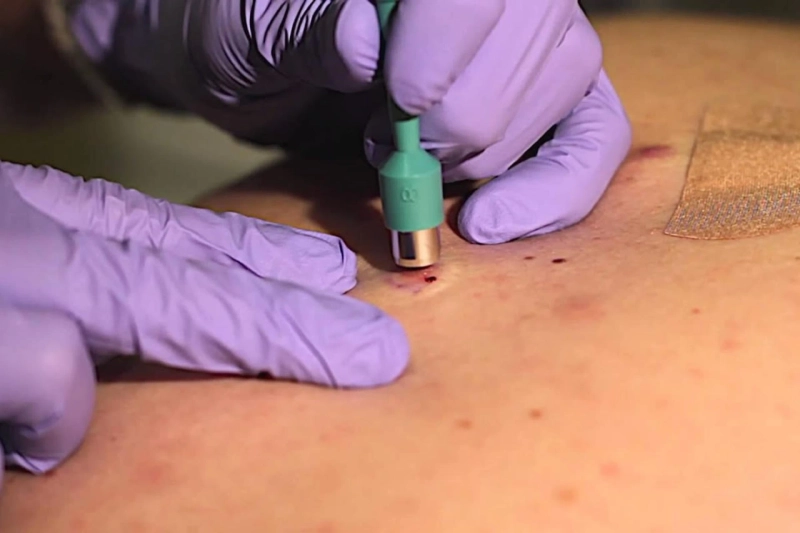Over the past few years, the skin biopsy market has been experiencing significant growth due to the increasing prevalence of skin diseases, rising demand for early diagnosis, and technological advancements in the field of dermatology. Skin biopsy is a minimally invasive procedure that involves the removal of a small piece of skin tissue for diagnostic or therapeutic purposes. It is an important tool in dermatology for the diagnosis and treatment of a wide range of skin conditions, including skin cancer, psoriasis, and other skin disorders.
According to a recent study by Allied Market Research, the global skin biopsy market is expected to showcase a notable CAGR from 2022 to 2031.
One of the key drivers of the skin biopsy market is the increasing prevalence of skin diseases, such as skin cancer. According to the American Cancer Society, skin cancer is the most common type of cancer in the United States, with more than 5 million cases diagnosed each year. Skin biopsy is an important tool in the early detection of skin cancer, which is critical for successful treatment.
Another driver of the skin biopsy market is the rising demand for early diagnosis. Early diagnosis is important for the successful treatment of skin conditions, as it allows for prompt intervention and prevents the progression of the disease. Skin biopsy is a key tool in early diagnosis, as it provides accurate and reliable diagnostic information.
Recent Technological Advancement:
The skin biopsy market has witnessed several recent technological advancements in the field of dermatology that are also driving the growth of the skin biopsy market. Advancements such as liquid biopsy, digital pathology, molecular diagnostics, artificial intelligence, and 3D printing are improving the accuracy and speed of diagnosis, as well as enabling personalized treatment plans. These technological advancements are expected to drive the growth of the skin biopsy market in the coming years. The following are detailed explanations of them:
Liquid biopsy: Liquid biopsy is a non-invasive technique that involves the analysis of blood or other body fluids for the detection of cancer cells or DNA fragments. This technique is being used in skin cancer diagnosis and is expected to drive the growth of the skin biopsy market. Digital pathology: Digital pathology involves the use of digital images for the diagnosis of skin conditions. It offers several benefits, such as improved accuracy, faster diagnosis, and remote consultation. Digital pathology is expected to drive the growth of the skin biopsy market. Molecular diagnostics: Molecular diagnostics involves the analysis of DNA, RNA, and proteins for the diagnosis of skin conditions. It provides accurate and reliable diagnosis and is being increasingly used in skin biopsy procedures. Artificial intelligence: Artificial intelligence is being used in skin biopsy procedures to analyze digital images and provide accurate diagnoses. It offers several benefits, such as improved accuracy and faster diagnosis, and is expected to drive the growth of the skin biopsy market. 3D printing: 3D printing is being used to create models of skin lesions for diagnosis and treatment planning. It offers several benefits, such as improved accuracy and faster diagnosis, and is expected to drive the growth of the skin biopsy market.Recent trends in the skin biopsy market:
The skin biopsy market has witnessed several recent trends that are shaping the industry and driving its growth. The top trends are listed below:
Increasing incidence of skin cancer: The rising incidence of skin cancer is driving the demand for skin biopsies. Skin biopsies are used to diagnose skin cancer and determine the stage of the disease, which helps in planning the treatment. Advancements in diagnostic techniques: The development of advanced diagnostic techniques, such as immunohistochemistry and molecular diagnostics, is driving the growth of the skin biopsy market. These techniques provide accurate and reliable diagnoses of skin conditions, which is driving their adoption. Growing demand for minimally invasive procedures: The demand for minimally invasive procedures is increasing, as they offer several benefits, such as reduced scarring, faster recovery, and lower risk of complications. Skin biopsies are minimally invasive procedures, which drive their adoption. Increasing focus on personalized medicine: The growing focus on personalized medicine is driving the demand for skin biopsies. Skin biopsies can provide information on the genetic makeup of skin cells, which can be used to develop personalized treatment plans. Rising awareness about skin health: The increasing awareness about skin health is driving the demand for skin biopsies. Skin biopsies can help in the early detection of skin conditions, which can lead to better outcomes and improved quality of life.Recent Development:
One of the most significant recent developments is that Roche and Foundation Medicine collaborated in June 2018 to develop a comprehensive genomic profiling test for skin cancer. The test is designed to provide information on the genetic makeup of skin cells and help in the development of personalized treatment plans.
Another key development was that Becton, Dickinson and Company and PathAI have collaborated to develop artificial intelligence-based solutions for skin cancer diagnosis. The solutions are designed to improve the accuracy and speed of diagnosis, which can improve results for patients' safety.
Furthermore, Philips and PathAI have teamed up to build deep learning applications and develop artificial intelligence-based solutions for skin cancer diagnosis. The solutions are designed to analyze digital images and provide accurate diagnoses, which can improve patient outcomes.
Conclusion:
Skin biopsy is an important tool in the diagnosis and treatment of skin conditions, and its importance is expected to continue to grow over the next few years. The market presents opportunities for companies in the field of dermatology to develop innovative products and solutions that improve the accuracy and speed of diagnosis as well as enable personalized treatment plans.
Ref: https://www.alliedmarketresearch.com/skin-biopsy-market-A13431
Author’s Bio: - Harshada Dive is an engineer by qualification. She has previous experience working as a customer service associate. As an associate content writer, she loves to experiment with trending topics and develop her unique writing skills. When she's not writing, Harshada enjoys gardening and listening to motivational podcasts.


